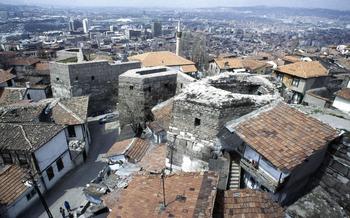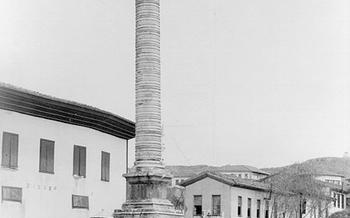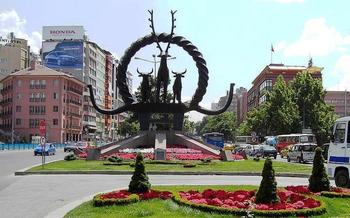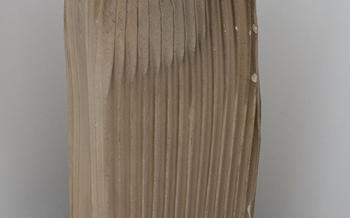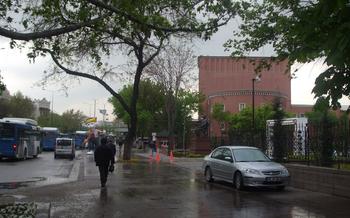
Temple of Augustus and Rome
- Historical Significance
- Location and Accessibility
- Architectural Features
- Historical Context
- Excavation and Restoration
- Religious Significance
- Cultural Importance
- Tourism and Popularity
- Admission and Fees
- Photography and Videography
- Souvenirs and Merchandise
- Accessibility for Disabled Visitors
- Nearby Attractions
- Best Time to Visit
- Insider Tip:
Historical Significance
The Temple of Augustus and Rome, a magnificent testament to ancient Roman grandeur, stands as a symbol of Ankara's rich history. Built in the heart of the city during the reign of Emperor Augustus, this temple was dedicated to the worship of the Roman emperors, who were considered divine figures. The temple's impressive architectural style, characterized by towering Corinthian columns, intricate friezes, and a majestic pediment, reflects the power and glory of the Roman Empire. As you explore this sacred site, you'll gain insights into the religious beliefs, political structures, and architectural achievements of one of the most influential civilizations in history.
Location and Accessibility
The Temple of Augustus and Rome is situated in the heart of Ankara, Turkey, within the historical Ulus district. It stands proudly in the Augustus and Rome Square, a prominent public space that serves as a gateway to the city's ancient past. The temple's central location makes it easily accessible by public transportation, with several bus lines and metro stations nearby. For those arriving by private vehicle, ample parking is available in the surrounding streets. Additionally, the temple's proximity to other popular tourist attractions, such as the Ankara Castle and the Museum of Anatolian Civilizations, allows visitors to conveniently combine their visit with a comprehensive exploration of the city's rich history and culture. The temple is wheelchair accessible, ensuring that visitors with disabilities can fully experience its grandeur.
Architectural Features
The Temple of Augustus and Rome in Ankara, Turkey, stands as a testament to the grandeur and power of the Roman Empire. Its architectural style is a blend of Greek and Roman influences, showcasing the empire's vast cultural heritage. The temple is constructed using local limestone, which has weathered over time to a warm golden hue, adding to its majestic appearance.
The temple's most striking feature is its imposing façade, adorned with a row of six massive Corinthian columns. These monolithic columns, each standing over 13 meters tall, are fluted with intricate carvings that depict acanthus leaves and other decorative motifs. The columns support a triangular pediment, which features a relief depicting a scene of Roman triumph, with figures of emperors and gods in procession.
The temple's interior is accessed through a grand entrance, leading to a spacious cella, or main chamber. The cella was once home to statues of the Roman emperors Augustus and Rome, to whom the temple was dedicated. The walls of the cella are adorned with niches and pilasters, adding depth and dimension to the space. The temple's overall design, with its harmonious proportions and intricate details, reflects the architectural prowess of the Roman Empire and its commitment to creating enduring monuments that symbolized its power and prestige.
Historical Context
The construction of the Temple of Augustus and Rome took place during a significant period in Roman history. The Roman Empire was at its peak, and the temple was built as a testament to the power and authority of the emperors. It was a time of great prosperity and expansion, and the temple reflected the grandeur and opulence of the empire.
The temple was dedicated to the Roman emperors Augustus and Rome, who were considered divine figures. This dedication was a way to honor and legitimize the authority of the emperors, as well as to promote the idea of a unified empire under their rule. The temple was also a symbol of the Roman Empire's religious beliefs and practices, and it played an important role in the religious life of the city.
The construction of the temple was also influenced by the political climate of the time. The Roman Empire was facing various challenges, including internal conflicts and external threats. The temple was built as a symbol of unity and strength, and it was meant to inspire loyalty and devotion among the Roman people.
The Temple of Augustus and Rome was not just a religious or political symbol; it was also a cultural and artistic masterpiece. The temple's architecture, sculptures, and decorations reflected the high level of craftsmanship and artistry that existed in the Roman Empire. It was a testament to the creativity and skill of the Roman people, and it continues to be admired and studied by historians and archaeologists today.
Excavation and Restoration
The Temple of Augustus and Rome underwent extensive excavation and restoration efforts in the 20th century. In the 1930s, Turkish archaeologists began excavating the site, uncovering the temple's ruins and revealing its once-grandiose structure. During these excavations, significant discoveries were made, including fragments of sculptures, inscriptions, and architectural elements that shed light on the temple's history and design.
The restoration work on the temple commenced in the 1960s and continued for several decades. The goal of the restoration was to preserve the temple's remaining structures and restore them to their original appearance as much as possible. Archaeologists and conservators meticulously reconstructed the temple's columns, pediment, and other architectural features using original materials and techniques.
The restoration work faced several challenges, including the need to stabilize the temple's foundations, repair damaged sections, and replace missing elements. Despite these challenges, the restoration efforts were largely successful, and the Temple of Augustus and Rome now stands as a testament to the skill and dedication of its ancient builders and modern-day conservators.
Although the temple has been restored to a significant extent, it is important to note that it is still an archaeological site and ongoing excavations and research continue to uncover new insights into its history and significance.
Religious Significance
The Temple of Augustus and Rome held great religious significance in the Roman Empire, serving as a center for imperial cult worship. The Romans believed that their emperors were divine beings, and the temple was dedicated to honoring and worshiping the emperors Augustus and Rome. Religious ceremonies and rituals were performed within the temple, and citizens would come to pay homage to the emperors and seek their blessings. The temple also served as a symbol of the emperor's power and authority, reinforcing the idea that the Roman Empire was divinely ordained and protected by the gods. Furthermore, the temple's dedication to both Augustus and Rome represented the unity and cohesion of the vast Roman Empire, as it symbolized the merging of the imperial cult with the worship of the city of Rome itself.
Cultural Importance
The Temple of Augustus and Rome holds immense cultural significance for the city of Ankara. As a symbol of the city's rich history and connection to the Roman Empire, it has played a pivotal role in shaping the cultural identity of Ankara. The temple serves as a reminder of the city's ancient heritage and its enduring legacy as a cultural and historical center.
Throughout history, the temple has been used for various cultural events and activities, showcasing its adaptability and versatility. From religious ceremonies and festivals to art exhibitions and performances, the temple has provided a unique and atmospheric setting for a diverse range of cultural expressions.
Moreover, the temple's cultural importance extends beyond its physical presence. It has inspired countless works of art, literature, and music, becoming a muse for creative minds across generations. This cultural legacy ensures that the temple's significance endures far beyond its ancient origins, continuing to shape the cultural landscape of Ankara and beyond.
Tourism and Popularity
The Temple of Augustus and Rome is a major tourist attraction in Ankara, drawing visitors from around the world. Its historical significance, architectural beauty, and religious importance make it a must-see destination for anyone interested in ancient history, architecture, or religion. The temple is particularly popular with history buffs, architecture enthusiasts, and religious pilgrims.
Many tourists visit the temple as part of a guided tour of Ankara, which typically includes other popular attractions such as the Ankara Castle and the Museum of Anatolian Civilizations. Guided tours provide visitors with valuable insights into the history and significance of the temple and allow them to ask questions and learn more about its unique features.
The temple is also a popular spot for photography and videography. Visitors can capture stunning images of the temple's impressive facade, intricate carvings, and surrounding ruins. Photography and videography are permitted within the temple, but visitors are asked to be respectful of other visitors and to avoid using tripods or other equipment that may obstruct the views of others.
Admission and Fees
Visiting the Temple of Augustus and Rome is an affordable and accessible experience. Admission to the temple is free of charge, allowing visitors to explore its ruins and admire its architectural grandeur without any financial burden. The temple is open to the public daily, providing flexibility for visitors to plan their visit according to their schedule.
While admission is free, guided tours are available for those who wish to delve deeper into the history, significance, and architectural details of the temple. Guided tours typically have a nominal fee and can be arranged through local tour operators or by contacting the temple authorities directly. These tours provide valuable insights and information, enhancing the visitor's understanding and appreciation of the temple.
Please note that special events or exhibitions held at the temple may require additional fees or charges. It is advisable to check with the temple authorities or local tourism offices for information on any upcoming events and associated costs.
Photography and Videography
Photography and videography are allowed within the Temple of Augustus and Rome, but there are some restrictions and guidelines that visitors need to be aware of. The use of tripods, monopods, and flash photography is prohibited inside the temple to preserve the integrity of the ancient structure. Visitors are also asked to be respectful of other visitors and to avoid taking photos or videos that may disrupt their experience.
For professional photography or filming, a special permit is required from the Turkish Ministry of Culture and Tourism. This permit can be obtained by submitting an application and paying a fee. Professional photographers and videographers must also comply with the same restrictions and guidelines as other visitors, such as not using tripods or flash photography inside the temple.
To capture the best photos and videos of the Temple of Augustus and Rome, it is recommended to visit during the early morning or late afternoon when the lighting is most favorable. Visitors should also take their time to explore the temple from different angles and perspectives to capture its grandeur and unique features.
Souvenirs and Merchandise
The Temple of Augustus and Rome offers a variety of souvenirs and merchandise for visitors to remember their visit. These items can be purchased from the gift shop located near the temple entrance. Souvenirs typically include postcards, magnets, replicas of the temple's architectural features, and books about the temple's history and significance. There are also a variety of unique and exclusive items available, such as limited-edition prints of the temple and hand-crafted pottery inspired by the temple's design. These souvenirs are a great way to preserve the memory of your visit and share the history of the temple with others. Whether you're looking for a small token or a special gift, you're sure to find something to your liking at the Temple of Augustus and Rome gift shop.
Accessibility for Disabled Visitors
The Temple of Augustus and Rome is committed to providing equal access and a welcoming experience for visitors with disabilities. The temple's exterior and interior are wheelchair accessible, with ramps and elevators available to facilitate movement throughout the site. Visitors with disabilities can easily navigate the temple's grounds and explore its various features, including the temple's interior, courtyard, and surrounding gardens.
The temple's staff is trained to assist visitors with disabilities and provide any necessary accommodations. Wheelchairs are available for rent at the temple's entrance, and visitors can request assistance with directions, navigation, or any other needs they may have. Additionally, the temple offers guided tours in sign language for visitors who are deaf or hard of hearing, and audio guides with descriptive content for visitors who are blind or visually impaired.
By providing these accessibility features and services, the Temple of Augustus and Rome ensures that all visitors, regardless of their abilities, can enjoy and appreciate the temple's historical significance and architectural beauty.
Nearby Attractions
The Temple of Augustus and Rome is surrounded by a wealth of other historical and cultural attractions that visitors can easily explore on foot or by public transportation. Just a short walk away is the Ankara Castle, a magnificent 13th-century fortress that offers panoramic views of the city. The Hamamönü district, with its charming Ottoman-era houses, is another must-visit, as is the Old Town, where visitors can wander through narrow cobblestone streets and discover hidden gems like the Aslanhane Mosque and the Ahi Elvan Mosque.
For those interested in art and history, the Museum of Anatolian Civilizations, located just a few minutes from the temple, is a treasure trove of artifacts from various civilizations that have inhabited the region throughout history. The Cer Modern, a contemporary art museum housed in a former tobacco factory, is also worth a visit.
Nature lovers can escape the hustle and bustle of the city at the Gençlik Park, a large park with a lake, walking trails, and a zoo. The park is a popular spot for picnics, jogging, and cycling.
Best Time to Visit
The best time to visit the Temple of Augustus and Rome, and indeed Ankara as a whole, is during the shoulder seasons of spring (April-May) and autumn (September-October). During these months, the weather is generally pleasant, with warm days and cool nights. The crowds are also smaller compared to the peak summer season, making it easier to explore the temple and other attractions without feeling rushed.
Summer (June-August) can be hot and dry in Ankara, with temperatures often exceeding 30 degrees Celsius. However, this can also be a good time to visit if you enjoy warm weather and don't mind the crowds. Just be sure to stay hydrated and wear sunscreen.
Winter (November-March) in Ankara can be cold and snowy, with temperatures dropping below freezing. While this may not be the ideal time to visit the Temple of Augustus and Rome, it can be a magical experience to see the ancient ruins covered in a blanket of snow.
Throughout the year, the Temple of Augustus and Rome hosts various special events and festivals. For example, the Ankara International Film Festival takes place in March, while the Ankara Music Festival is held in June. If you're interested in attending one of these events, be sure to plan your visit accordingly.
Insider Tip:
Uncover the Temple's Hidden Underground Chamber
Beneath the Temple of Augustus and Rome lies a hidden treasure—a secret underground chamber that few visitors know about. This chamber, which is not typically open to the public, offers a unique glimpse into the temple's past and provides a deeper understanding of its significance.
To access the chamber, visitors should inquire at the ticket office about the possibility of a guided tour. If available, the tour will take visitors through a narrow passageway leading to the hidden chamber. Inside, visitors can marvel at the well-preserved ancient artifacts, including statues, inscriptions, and pottery fragments.
The underground chamber provides a fascinating glimpse into the temple's religious rituals and ceremonies. It is believed that the chamber was used for secret meetings and initiations, adding to the temple's mystique and allure.
Exploring the hidden underground chamber is a truly unique experience that allows visitors to connect with the temple's ancient past and discover its hidden secrets. Don't miss this opportunity to delve deeper into the history and significance of the Temple of Augustus and Rome.


